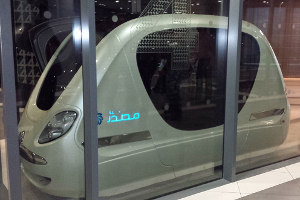Motor insurance facing the challenge of new technologies
 © Peter Firminger, CC BY 2.0 © Peter Firminger, CC BY 2.0 |
Its appearance and powertrain evolved from there, to make way for the creation in 1893 of the first gasoline-powered four-wheel car by Charles Edgar Duryea and his brother who would soon set up the first car manufacturing business in the United States.
The first compulsory motor third party liability insurance will be sold four years later in 1897 in Dayton, Ohio.
The first policyholder of this motor insurance was named Gilbert J. Loomis. He contracted a policy covering against all property damage or/and bodily injury that he would cause to others while driving his vehicle. The very first motor third party liability insurance policy was sold by Travelers Insurance Company for the sum of one thousand dollars.
Five years later, in 1902, the first motor insurance policies covering fire and theft were created. In 1912, insurance companies crafted a motor scheme combining third party liability, fire and theft covers. Those policies were the first drafts of motor third party liability and property damage insurance as we know them today.
Controversial or discreetly challenged during its early hours, motor insurance finally came into shape after the First World War when the use of motor-powered vehicles would shift from occasional luxury, reserved for a certain class, to a daily means of locomotion. This means of transport was anchored gradually in the manners of the people, and with road accidents multiplying, it quickly became essential to make motor insurance compulsory to protect motorists as well as the people and the property evolving within the same environment. Massachusetts and Connecticut in North America were the first two states to pass a bill in this regard in 1925.
Technological developments over the following years made it possible for the automobile industry to expand exponentially, especially when it came to security. We are far and away from those times when the only security available to the man behind the wheel was the brake pedal. Nowadays cars are equipped with sensors and detectors of all kinds, to aid braking, driving, parking, etc, taking into account that driverless cars will soon hit the roads
The technology has relentlessly evolved to the point of becoming a threat to the stability and longevity of motor insurance.
Evolution of motor safety technologies
Originally created with its brake and head lights for protection systems, cars have ever since undergone many changes and improvements in terms of safety equipment.
The windshield wiper
The invention of the first operational windshield wipers is attributed to Mary Anderson, American real estate developer and winemaker who, in 1903, patented her invention as the "window cleaning device", a system controlled by a lever located inside the vehicle.
Electronically-controlled wipers appeared almost twenty years later, patented in 1922 by Willian Folberth in the United States.
Usefulness: Windshield wipers allow the driver to keep a good view of the road, thus reducing the risk of accidents in wet weather.
The airbag
 Airbag © Alexauto321 , CC BY-SA 3.0 Airbag © Alexauto321 , CC BY-SA 3.0 |
Airbags as we know them today were invented by Walter Linderer (1941)in Germany, and John Hetrick (1951) in America.
Because of the slowness of their deployment, airbags were, since their creation in Germany, considered hardly practical for maximum safety. Twenty years later, Ford, in the USA, deployed John Hetrick ‘s airbags. Compressed air was then replaced by sodium azide and crash detectors were installed at the front of the vehicle to control the inflation of the cushions.
Previously used to replace the safety belt, they are currently considered as supplements thereto and classified as SRS “Supplementary Restraint System".
Usefulness: Airbags greatly reduce the likelihood of death and injury in case of road crash.
The ABS braking system (Anti-lock Braking System)
The ABS system is none other than the development of conventional braking as crafted during the creation of the first automobiles.
Based on the habits car race pilots, ABS is designed to prevent full wheel lock, imposing a braking threshold and pace.
Usefulness: The ABS system reduces braking distance to avoid wheel lockup and therefore uncontrolled skidding, and the risk of collision.
The Electronic Stability Program (ESP)
 © Chris , CC BY-SA 2.0 © Chris , CC BY-SA 2.0 |
ESP is a program installed on cars to monitor and reduce, by means of an integrated computer, loss of traction, enabling the vehicle to maintain optimal stability.
The traction control systems were first introduced in Germany in 1987 in the Mercedes- Benz and BMW factories. The mechanism was initially designed to just ensure braking control of individual wheels. It was not until 1992 that the two German automakers, in partnership with Robert Bosch GmbH, developed a system capable of controlling the brakes at each wheel while detecting loss of steering control.
The ESP system automatically applies pressure on the brakes when it detects a loss of steering control. This pressure is applied differently depending on the vehicle position and the direction in which the driver wants to go. It can also be applied to each wheel individually.
Some of these programs may also reduce engine power until control of the vehicle has been restored.
Usefulness: The ESP system minimizes the risk of loss of vehicle control, thus reducing the probability of collision.
Speed limiters and cruise control devices
- Cruise control: Invented in 1948 by the American mechanical engineer Ralph Teetor, the cruise control would be marketed for the first time in 1958. Its operating principle has improved over time, but the basic elements remained unchanged. An Engine Control Mechanism (ECM) receives data from a speed sensor installed at the gearbox outlet. The ECM performs corrections of engine speed according to the speed set in advance by the vehicle user.
- Speed limiters: Extension of cruise control devices, speed limiters allow motorists to set a speed they do not want to exceed. They may be used alone or to complement cruise control systems.
Usefulness: Speed limiters and cruise control devices guard motorists and third parties against speeding and the risk of collision.
Detectors and sensors
 Vehicle equipped with a camera © Steve Jurvetson , CC BY 2.0 Vehicle equipped with a camera © Steve Jurvetson , CC BY 2.0 |
Basic components of security systems, detectors and sensors are essential to the application of all technologies mentioned above, and whose development rests on the evolution of the detectors and sensors that provide a link between the vehicle, the onboard computer and the man behind the wheel.
The computer processes the data transmitted by the detectors and sensors to convey essential information to the driver, or turn on the different safety systems of the vehicle. These actions can range from simple trigger of windshield wipers, automated car park (Park 4 U system) to the calculation of the fuel level or the detection of white stripes on the road.
Usefulness: detectors and sensors are essential for the efficient operation of modern safety systems.
Motor insurance and technology: the special case of driverless cars
Historical background, from the 1920s to the 2000s
The concept of driverless cars started in the 1920s, more precisely in 1925 when Houdina Radio Control, radio equipment company founded by Francis P. Houdina, presented its Linrrican Wonder in the streets of New York, a remote-controlled driverless prototype monitored by an antenna mounted on the hood.
In 1939, Norman Bel Geddess came up with the Futurama model whose design was sponsored by General Motors, an electric car powered by integrated circuits and controlled by radio.
The 1950s, 1960s and 1970s have also witnessed the emergence of some driverless prototype cars. In 1958, RCA Labs developed in collaboration with General Motors, a real-size model of the miniature tested in 1953 by its engineers. The concept consisted in outfitting the roads with sensors that guided vehicles by means of radio waves.
In 1960, the UK Transport and Research Laboratory tested a driverless Citroën DS. The car, controlled by magnetic cables integrated to the road, was launched at 130 km/h without deviating from its trajectory. In the 1970s, Bendix Corporation developed and tested a prototype connected to communicators positioned on roadsides and whose function was to convey messages from a computer.
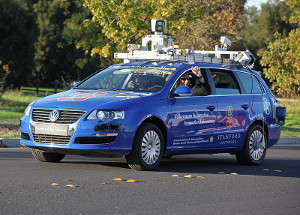 Driverless vehicle © Steve Jurvetson , CC BY 2.0 Driverless vehicle © Steve Jurvetson , CC BY 2.0 |
From 1980 to the 2000s, technological developments had enabled researchers to go even further in the design of autonomous cars. This period saw the realization of ALV (Autonomous Land Vehicle) project, sponsored by DARPA (Defense Advanced Research Projects Agency) and developed by Universities of Maryland and Carnegie Mellon, Stanford Research Institute (SRI), Michigan’s Environmental Research Institute, and Martin Marietta. Using laser radar, a computer vision, and a check carried out by a robot, ALV was pushed to 31 km/h on the first demonstration. It was then able to walk 610 m off- track at a speed of 3.1 km/h.
Later, during the first decade of the 2000s, the American government financed three driverless cars, known under the names of «Demo I », «Demo II» and «Demo III». These three driverless vehicles were developed by DARPA and the U.S. Army.
In recent years, many car manufacturers have engaged in the development and design of cars without drivers. Oftentimes in partnership with IT specialists, they were able to produce fully autonomous and operational vehicles.
Driverless cars equipment
In addition to the basic equipment of cars already sold, driverless vehicles are outfitted with:
- software that receives the information and controls the vehicle,
- a Lidar sensor (laser radar) set on the vehicle roof which enables the software to create a 3D map of its surrounding, computing the distance between the vehicles and surrounding objects at a 360 ° scan with a laser beam,
- radar sensors to prevent collisions which detect nearby objects or other vehicles and allow the software to activate the cruise control,
- cameras that transmit real-time detailed three-dimensional images of the vehicle surrounding,
- GPS receiver used in addition to the Lidar sensor for mapping,
- sensors on the drive wheels.
The Google cars
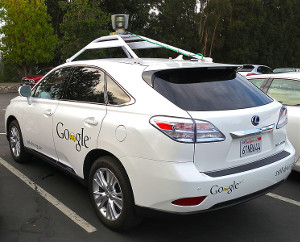 Google Driverless Car © Steve Jurvetson, CC BY 2.0 Google Driverless Car © Steve Jurvetson, CC BY 2.0 |
Based on the Google Driverless Car project led by Google Inc. and initiated by Sebastian Thrun, the Google driverless cars are already manufactured vehicles on sale on automobile markets. They are modified by the company to make them fully autonomous and able to move without any human intervention. The software powering these vehicles is called Google Chauffeur.
In August 2012, the team in charge of the project proudly announced that 10 Google cars had traveled a total of 500 000 km in a real situation, with no accident being reported.
In the United States of America, only four states have passed laws authorizing driverless cars to hit public roads: California, Florida, Michigan and Nevada.
Legislations in this regard are also awaiting approval in the District of Columbia, New Jersey, Hawaii, and Oklahoma.
It should be noted that the use of these vehicles still requires a «recognition lap» with a driver at the wheel, to ensure that the software will record the exact data path.
Key dates of the driverless car
Many automakers are getting into designing driverless cars not with the outright intention to sell such vehicles in the near future, but rather to improve already existing systems on models sold.
The table below shows the milestones in the lives of autonomous cars since the beginning of the XXI century:
| Year | Event | Designer | Distance/Location | Country |
|---|---|---|---|---|
| 2005 | *Start of driverless cars tests | BMW | - | Germany |
| 2010 | * Tests of Audi TTS driverless | AUDI | Pike’s Peak (Colorado) | USA |
*Four driverless cars travel from Italy to China at the Intercontinental Autonomous Challenge VisLab | - | 15 900 km from Parma to Shanghai | Italy/China | |
| 2011 | *Creation of the EN-V | General Motors | - | USA |
*The State of Nevada authorizes driverless cars on public roads | - | Nevada | USA | |
*Licenses granted for «Spirit of Berlin» and «Made In Germany» | AutoNOMOS Group | Streets and highways of Germany | Germany | |
| 2012 | *Test of the Temporary Auto Pilo (TAP) | Volkswagen | - | Germany |
*1st license granted in the Nevada | - | Nevada | USA | |
*2 nd State to authorize driverless cars on public roads | - | Florida | USA | |
*3rd State to authorize driverless cars on public roads | - | California | USA | |
*Test of a fleet of driverless cars | Volvo | Highway | Spain | |
| 2013 | *Test of the S-Class Driverless | Mercedes Benz | 100km from Manheim to Pforzhein | Germany |
*Driverless cars are authorized on public roads | - | - | United Kingdom | |
*4rd State to authorize driverless cars on public roads | - | Michigan | USA | |
*Presentation of the Leaf Driverless | Nissan | California | USA | |
*Authorization for the Leaf to hit the public roads | Nissan | - | Japan | |
*1st demonstration of the Leaf on the roads | Nissan | Tokyo | Japan | |
| 2014 | *1st driverless car to be approved for sale | Induct Technology | - | USA |
Advantages and disadvantages of driverless cars
Advantages:
- Reducing the number of road accidents,
- Increasing highway capacity and reducing congestion,
- Downsizing traffic police members,
- Reducing pollution thanks to the decreased number of cars on the road.
Drawbacks:
- Inability to adjust vehicle course in keeping with gestures commanded by traffic warden,
- Difficulties to analyze the bands on the road in snowy weather,
- Inability to cope with changes if not listed on the map,
- Total uncertainty in a situation of cohabitation between driverless and conventional cars on public roads.
Public reception
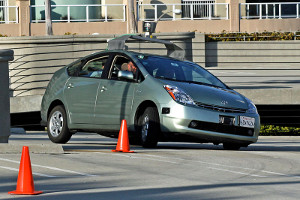 «driverless car» test © Steve Jurvetson , CC BY 2.0 «driverless car» test © Steve Jurvetson , CC BY 2.0 |
Although its drawbacks are relatively fewer that its advantages (upside outweighs the downside), driverless car is still struggling to win the confidence of the large public. Different surveys conducted worldwide show that most opinions are still divided regarding its use.
In 2011, a survey conducted online by Accenture, with 2006 English and American consumers found that only 49% of the people polled were in favor for the driverless car.
In 2012, JD Power & Associates conducted a survey of 17 400 car owners. The unfavorable outcome to driverless cars with only 37% fell even lower to 20% when respondents were informed of the additional cost required for their acquisition.
More recent surveys have reported more mixed findings for the driverless car. The company PULS surveyed 1 000 German who have reported to be in favor of its use by 22%, 10% said they have no opinion on the question, 44% remain skeptical and only 24% are against its use.
| Masdar City (Abu Dhabi) | |
|---|---|
Located in the Emirate of Abu Dhabi, Masdar City is an eco-city model using renewable energy and clean technology. The futuristic project launched in 2008 is designed to build a town of 50 000 inhabitants, with a quality of life and greener working environment by 2020.
Masdar City: driverless cars Masdar City is experimenting with a public and private driverless transportation system. Cabins carrying 1 to 10 people automatically roll into the basement of the city. Depending on traffic and routes, vehicles traveling at 40 km/h independently choose the shortest path to get from one point to another. | |
Threats of new technologies on motor insurance
The never-ending technological progress aimed at minimizing the intervention of the car driver / owner poses a threat to the survival of motor insurance which is mainly based on the probability of occurrence of a car accident. Entrusting control of all vehicles to artificial intelligence designed to fully and strictly comply with traffic rules would sign the ultimate end of motor insurance.
Read also:
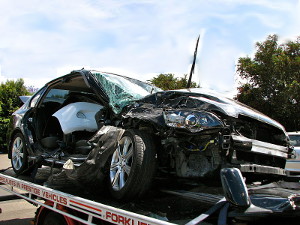 © Highway Patrol Images, CC BY 2.0 © Highway Patrol Images, CC BY 2.0 |
One can easily imagine that with minimized probability of road crash occurrence, governments will be forced to suppress the obligation of motor insurance. Hence, no motorist, if the term can still apply, will deem it necessary to underwrite such an insurance policy.
It remains nonetheless true that safeguarding the integrity of the embedded systems, their maintenance and monitoring will remain man-made. Moreover, the risks associated with computerization such as hacking or simply unexpected failure would simply mean that sub-categories of motor insurance should manage to survive this changing security technologies.
In the first years subsequent to the massive use of driverless cars, insurance companies would make huge profits through the decline in the number of accidents, but at the same time, the rate of renewal of these contracts would undoubtedly fall.
Eventually, one can conclude that the mere nature of motor insurance, which is the coverage of material or bodily claim, is poised to suffer greatly from the substitution of conventional cars by driverless cars, but not necessarily on the brink of extinction. Third party liability will be determined with reference to party, among the various players, involved in the release of the vehicle.
A collateral victim of the advent of driverless cars and this is probably one of the main reasons why the use of these vehicles will be restrained, is the government. The latter will automatically be losing all fines collected from motorists for various traditional road violations: speeding, driving under the influence of alcohol or without driving license, improper parking, use of a lane in the wrong direction, etc.
